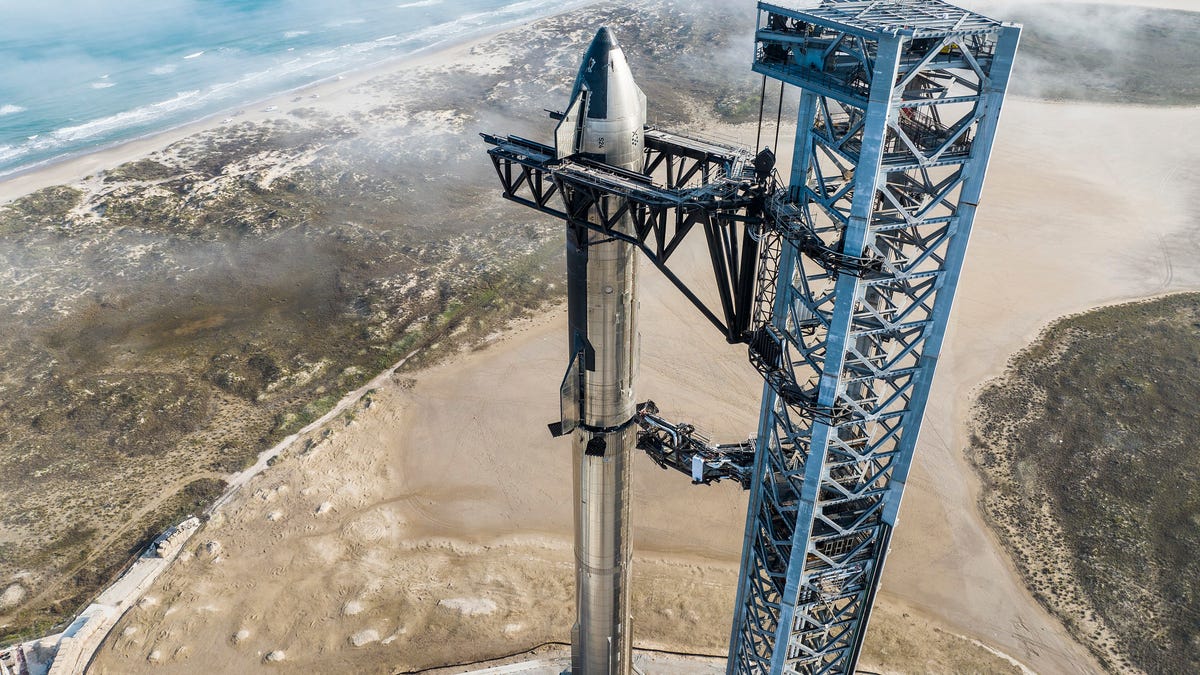Next Launch of SpaceX Starship Faces More Potential Delays
An investigation into April's explosive test flight has closed, but another agency needs time to review upgrades to Elon Musk's big rocket.

The Starship looks like it's ready to get off this rock.
While the Federal Aviation Administration has been working closely with SpaceX to approve the next launch of Starship, a required environmental review by a different federal agency could keep the vehicle grounded for months longer.
The US Fish and Wildlife service told Bloomberg on Monday that it has yet to begin its review of a new water deluge system that SpaceX plans to operate during its next launch. The agency is working with the FAA to complete its part of the permitting process, but said it has not yet received all the materials it needs to begin the review, which could take anywhere from one to four months.
The new deluge system is meant to dampen some of the significant heat and force from the launch. Starship's first orbital launch attempt in April essentially destroyed much of the launch pad at the company's Starbase facility in Texas.
Meanwhile, the head of the FAA is positive about Starship's progress toward another flight.
"We're working well with them and have been in good discussions," interim FAA Administrator Polly Trottenberg told reporters Sept. 13, according to Reuters.
The FAA said on Sept. 8 it had closed its investigation into the "mishap" ending of Starship's first orbital flight attempt on April 20. That test ended with the vehicle being intentionally destroyed after the first stage Super Heavy booster failed to separate from the main Starship itself.
The FAA, which oversees commercial spaceflight in the US, sent a letter to SpaceX outlining a list of 63 corrective actions to be taken before a launch license will be issued for the next Starship orbital flight attempt.
SpaceX founder Elon Musk said most of those changes are done and he's ready to blast off.
To be clear, the list of changes was developed in cooperation with SpaceX engineers and approved by the FAA. The way the process actually works is that SpaceX determines what it thinks caused the mishap and submits a report, including corrective actions, to the FAA. That report was submitted Aug. 21. As part of its side of the investigation, the FAA reviewed that report and sent over a final list of required changes to SpaceX last week.
"Corrective actions include redesigns of vehicle hardware to prevent leaks and fires, redesign of the launch pad to increase its robustness, incorporation of additional reviews in the design process, additional analysis and testing of safety critical systems," the FAA said in a statement.
The agency emphasized that "the closure of the mishap investigation does not signal an immediate resumption of Starship launches."
Just days before the FAA announcement, SpaceX and Musk said on X (formerly Twitter) that a new Starship prototype, dubbed Ship 25, had been stacked atop a new Super Heavy booster and that the mated pair was ready to launch.
SpaceX later released a statement of its own that pinpointed the failure of the April 20 test flight.
"During ascent, the vehicle sustained fires from leaking propellant in the aft end of the Super Heavy booster, which eventually severed connection with the vehicle's primary flight computer," the statement reads. "This led to a loss of communications to the majority of booster engines and, ultimately, control of the vehicle."
So when will Starship fly?
The company says it has since made numerous fixes, upgrades and other mitigations to Starship, its testing regime and its launch infrastructure. The launch pad at the SpaceX Starbase facility in south Texas was partially destroyed during the April blastoff.
Musk said on X on Sept. 10 that the SpaceX team had completed 57 of the improvements required by the FAA and that the remaining six items refer to future actions for later flights.
However, the FAA's letter sent to SpaceX on Sept. 7, which was shared with myself and other reporters, implied that the company has not yet submitted its application for a launch license for Starship's next attempt at reaching space.
So it appears Starship is getting closer to launching again, but there's still some work to be done, including the Fish and Wildlife Service's environmental review, which now seems to be the highest hurdle to clear.
If the agency begins that review soon, we could still see an October launch under the best case scenario. It's also conceivable it gets pushed to 2024.
Stay tuned.

